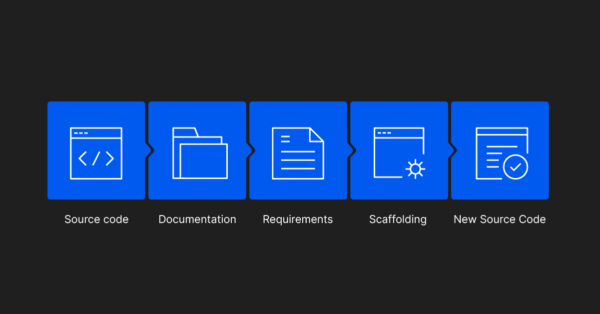Enterprise organizations often share one major technological hurdle: They run on legacy software that costs billions of dollars annually to fix and maintain.
It’s called technical debt, and the Wall Street Journal recently illustrated the scope of the problem in hard numbers: Technical debt is estimated to cost companies $2.4 trillion a year in cybersecurity, operational failures, failed development projects, maintenance of outdated systems, and will cost an additional $1.52 trillion to fix.
In addition to the costs, legacy code is holding companies back from future growth and innovation. According to the WSJ, 87% of IT leaders said the complexity of their existing infrastructure is the biggest impediment to implementing next-generation services. The difficulty of working with legacy code, especially without proper tests, further complicates efforts to modernize systems. And 42% of IT budgets are tied up in legacy infrastructure, application development, and maintenance. Change is necessary to modernize these systems, improve functionality, and add new features while balancing the risks involved.
Over the past several months, this issue came up multiple times in our conversations with C-level leaders at several prominent institutions, and it got us thinking: What can Dualboot Partners do to help?The answer is 3PO.
Overview of System Modernization
Modernization of legacy systems stands as the crucial cornerstone for businesses seeking to maintain competitive edge and operational efficiency. Legacy systems, though once cutting-edge, transform into significant barriers to innovation and business growth over time. We deliver comprehensive modernization solutions that enable organizations to leverage newer technologies and services with minimal disruption. Our modernization approach involves meticulous planning and seamless execution to ensure a smooth transition journey. We bring extensive expertise in understanding existing system architectures, their complex dependencies, and inherent limitations, excelling in transformation strategies.
The ultimate goal of our software modernization services is to create robust, scalable, and secure systems that perfectly align with your organization’s evolving demands. This transformation process leverages our expertise in refactoring legacy code, integrating powerful new systems, and delivering specialized training to your team members, ensuring rapid adoption and seamless transition. Organizations partnering with us for legacy system modernization experience reduced maintenance costs, enhanced compliance capabilities, and superior customer experiences. While modernization represents a complex journey requiring investment of time, resources, and capital, the business benefits far outweigh these initial investments. By embracing our modernization approach, we ensure your organization stands future-ready and perfectly equipped to navigate the challenges of today’s digital landscape.
Technical debt in source code explained
Imagine a major financial institution, one with a market capitalization of several billion dollars and a long history. Despite its success, this institution still runs on a core banking system that is considered outdated by software engineers due to its decades-old technology. Over the years, the bank added thousands of customizations and applications to that core system to keep pace with the organization’s growth. And it worked – for a while.
But Band-Aids only last so long. Now, that core system is costing the bank millions a year in repairs and maintenance. It’s inhibiting future growth, and it’s holding the entire institution back. Dealing with such legacy systems presents significant challenges, as they often fail to provide modern capabilities and keep businesses from progressing.
The opportunity for Legacy Systems
Legacy code systems are often poorly documented – if they are documented at all. As a result, no one inside the organization knows how the code works, making a technical upgrade impossible. With no documented requirements, it’s challenging to build a new system that maintains the functionality of the old one, which puts operations at risk.
Michael Feathers defines legacy code as code without automated tests, highlighting the difficulties in understanding and modifying such code.
The existing methods of securing that documentation are arduous, to say the least. It would take a team of people years to complete. But no business has the time or money for that. Instead, you need a translator – preferably one powered by generative AI.
So that’s what we built. 3PO is an AI-powered code translator that allows companies to migrate their legacy software to a modern technology stack in a fraction of the time and cost of the traditional method. What would take your internal team years takes 3PO weeks, and it’s a game changer for companies eager to expunge technical debt from their balance sheets and start prioritizing innovation and growth.
Strategies to upgrade legacy systems can be found in implementing Web-based interfaces and automated business process software, ensuring the operational history and reliability of these systems are maintained.
Security Challenges
Legacy systems pose significant security risks due to their outdated architecture and lack of modern security features. They become easy targets for cyber-attacks, compromising sensitive information and putting customer data at risk. With outdated programming languages, browsers, and operating systems, these systems create opportunities for exploitation. The absence of automated tests, clean code, and proper documentation further complicates identifying and fixing vulnerabilities.
To mitigate these risks, implement robust security measures like firewalls, encryption, and access controls. Regular updates and maintenance are crucial to ensure security and integrity. Sometimes, replacing legacy systems with newer, secure solutions is more cost-effective. By prioritizing security, organizations can protect customer information and maintain their reputation. Develop a comprehensive security strategy, including regular audits and vulnerability assessments, to address potential threats before they lead to catastrophic failures.
Migration to New Systems
Migrating to new systems is a complex process requiring careful planning, execution, and testing. It involves transferring data, applications, and other components from legacy systems to new systems, which can be challenging. Companies must ensure compatibility with existing infrastructure and proper integration of all dependencies. The migration should minimize downtime, ensure data integrity, and prevent business disruptions.
Understanding the legacy system’s limitations and vulnerabilities is crucial for a smooth transition. Companies should prefer phased migration, implementing the new system in stages to minimize risks. Automated tools can simplify migration and reduce errors. Although migration can be costly, it allows companies to leverage newer technologies, improve efficiency, and lower maintenance costs. Success hinges on careful planning, thorough testing, and a well-executed strategy.
How 3PO Transforms Legacy Code
3PO is both a product and a service designed to help businesses modernize their legacy systems and transition to new ones. It offers a comprehensive platform for refactoring outdated code, integrating modern systems, and ensuring compliance with regulatory standards.
Leveraging advanced technologies like artificial intelligence and machine learning, 3PO analyzes legacy systems to pinpoint areas ripe for improvement. The AI-powered tool meticulously reviews existing software applications, identifies the original developers, extracts core requirements, and then rewrites the application using a contemporary tech stack. This process unfolds in five key steps:
- Source Code Identification→ Locate the code within the current system.
- Documentation→ Record the functions that the code performs.
- Requirements Extraction→ Derive the necessary requirements for the new system from existing documentation.
- Scaffolding→ Propose structures for the migrated application.
- New Source Code Creation→ Deliver new code for the next generation of the system.
Throughout each stage, 3PO combines artificial and human intelligence. While AI accelerates the translation process, our engineers fine-tune the AI to ensure high-quality, polished outcomes for our customers. This transition allows organizations to interface with their legacy systems while benefiting from modern efficiency and ease of use, shielding users from the inefficiencies of older systems.
Designed to support a variety of programming languages, including Java, Python, and C++, 3PO can seamlessly integrate with existing systems and infrastructure. Its scalable, secure, and reliable platform makes it an ideal solution for businesses of all sizes.
Additionally, 3PO provides a team of experts to assist with the modernization process, ensuring organizations receive the necessary support to succeed. By employing 3PO, organizations can mitigate migration risks, ensure compliance, and enhance the overall quality of their systems. As a cost-effective solution, 3PO helps organizations save money and resources by reducing maintenance costs and boosting efficiency. With 3PO, organizations can modernize their legacy systems, leverage newer technologies, and enhance their competitiveness and operational efficiency.
3PO: A ‘universal translator’
Once we built this tool, we needed a name. In a brainstorming session, a member of our team suggested a nod to one of the most well-known and well-loved characters in the Star Wars franchise: C-3PO. In the films, the droid claims to be fluent in more than 6 million languages. He’s a universal translator.
To effectively work with legacy systems, it is crucial to learn about key concepts, best practices, and tools associated with them. Understanding these elements helps navigate the challenges of integrating older code into modern environments.
Now, so are we, enabling seamless integration of legacy components into a newer system.




